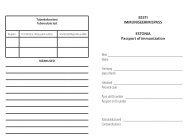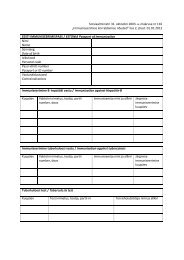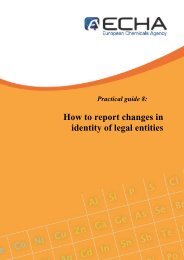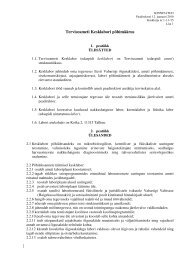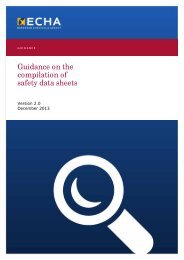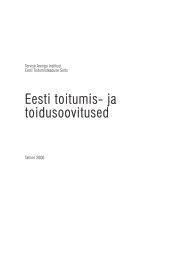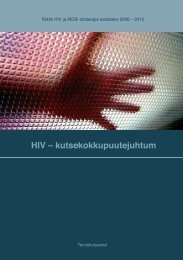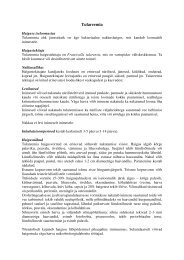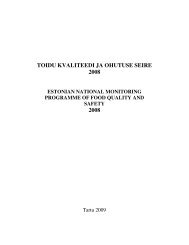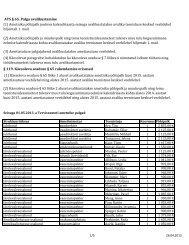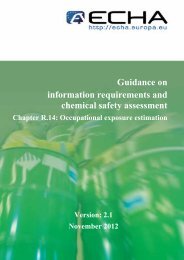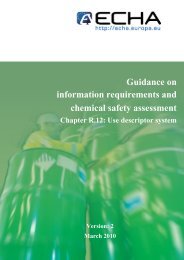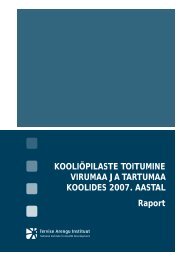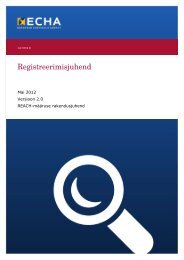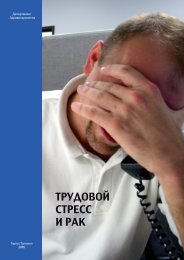Guidance on registration - ECHA - Europa
Guidance on registration - ECHA - Europa
Guidance on registration - ECHA - Europa
You also want an ePaper? Increase the reach of your titles
YUMPU automatically turns print PDFs into web optimized ePapers that Google loves.
<str<strong>on</strong>g>Guidance</str<strong>on</strong>g> <strong>on</strong> registrati<strong>on</strong><br />
Versi<strong>on</strong> 2.0 May 2012 53<br />
<br />
informati<strong>on</strong> <strong>on</strong> manufacture, uses, risk management measures and resulting exposures.<br />
Table 2 below presents an overview of the standard informati<strong>on</strong> requirements defined in<br />
REACH (Annex VII to X). For each t<strong>on</strong>nage band, REACH defines the minimum informati<strong>on</strong> that<br />
the registrant has to provide <strong>on</strong> the intrinsic properties of the substance. For the lowest<br />
t<strong>on</strong>nage level, the standard informati<strong>on</strong> requirements are defined in Annex VII, and when a<br />
new t<strong>on</strong>nage level is reached, the requirements of the corresp<strong>on</strong>ding Annex have to be added.<br />
These standard requirements may, however, be adapted (waived or increased) when<br />
appropriately justified according to the criteria set out in Annexes VII to XI. Therefore, for<br />
each substance the precise informati<strong>on</strong> requirements may differ depending <strong>on</strong> the<br />
available informati<strong>on</strong> <strong>on</strong> intrinsic properties as well as <strong>on</strong> t<strong>on</strong>nage, use and<br />
exposure.<br />
Where available data are not adequate to meet the requirements of REACH, additi<strong>on</strong>al testing<br />
may need to be generated. It should be noted that any study required to fulfil the informati<strong>on</strong><br />
requirements defined in Annex IX and X (see Table 2) should not be c<strong>on</strong>ducted by the<br />
registrant at the stage of registrati<strong>on</strong>. Instead the registrant will have to develop a testing<br />
proposal and include it in his registrati<strong>on</strong> dossier.<br />
It has to be stressed that where possible the registrant is obliged to share or generate<br />
data with other registrants of the same substance, instead of generating data by himself, if<br />
this would involve animal experiments (see secti<strong>on</strong> 4.1 <strong>on</strong> data sharing).<br />
Where tests <strong>on</strong> substances are required to generate informati<strong>on</strong> <strong>on</strong> intrinsic properties of<br />
substances, they must be c<strong>on</strong>ducted in accordance with the test methods laid down in<br />
Commissi<strong>on</strong> Regulati<strong>on</strong> (EC) No 440/2008 and its amendments or in accordance with other<br />
internati<strong>on</strong>al test methods recognised by the Commissi<strong>on</strong> or <strong>ECHA</strong>. Ecotoxicological and<br />
toxicological tests and analyses must be carried out in compliance with the principles of good<br />
laboratory practice or other internati<strong>on</strong>al standards recognised as being equivalent by <strong>ECHA</strong> or<br />
the Commissi<strong>on</strong> and with the provisi<strong>on</strong>s of Directive 86/609/EEC <strong>on</strong> the protecti<strong>on</strong> of animals<br />
used for experimental and other scientific purposes.<br />
Informati<strong>on</strong> <strong>on</strong> intrinsic properties of substances may be generated by using sources of<br />
informati<strong>on</strong> other than in vivo testing, The registrant may use a variety of alternative methods<br />
such as in vitro tests, (Q)SARs ((Quantitative) Structure Activity Relati<strong>on</strong>ships), grouping or<br />
read-across, provided that the use of alternative methods is justified. All these different<br />
sources of informati<strong>on</strong> can also be used in a weight of evidence approach.<br />
Available guidance<br />
The <str<strong>on</strong>g>Guidance</str<strong>on</strong>g> <strong>on</strong> informati<strong>on</strong> requirements and chemical safety assessment explains in detail<br />
the process for informati<strong>on</strong> gathering and data generati<strong>on</strong>. The following chapters may be<br />
particularly useful for the reader:<br />
Part B: Hazard Assessment<br />
Chapter R.2: Framework for Generati<strong>on</strong> of Informati<strong>on</strong><br />
Chapter R.3: Informati<strong>on</strong> Gathering<br />
Chapter R.4: Evaluati<strong>on</strong> of available informati<strong>on</strong><br />
Chapter R.5: Adaptati<strong>on</strong> of informati<strong>on</strong> requirements<br />
Chapter R.6: QSARs and grouping of chemicals<br />
Chapter R.7: Endpoint specific guidance<br />
Practical <str<strong>on</strong>g>Guidance</str<strong>on</strong>g> <strong>on</strong> alternative methods for the generati<strong>on</strong> of informati<strong>on</strong> <strong>on</strong> intrinsic<br />
properties of substances can also be found in the following documents:<br />
<br />
Practical Guide 1: How to report in vitro data<br />
Annankatu 18, P.O. Box 400, FI-00121 Helsinki, Finland | Tel. +358 9 686180 | Fax +358 9 68618210 | echa.europa.eu



